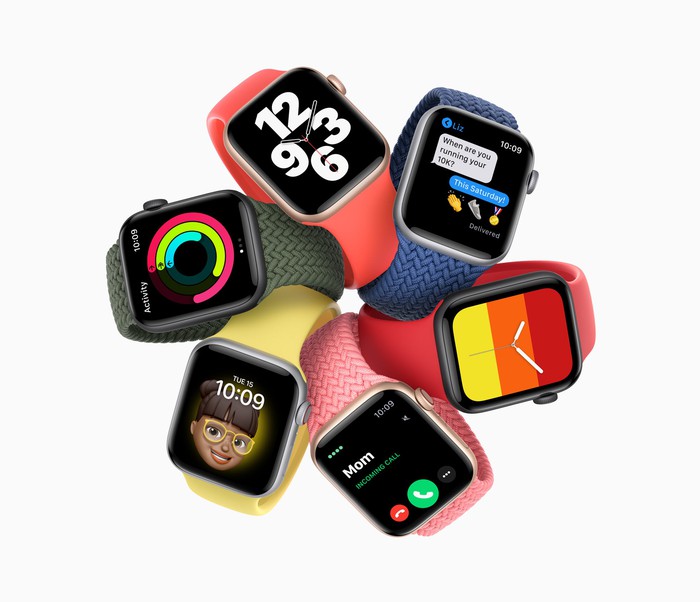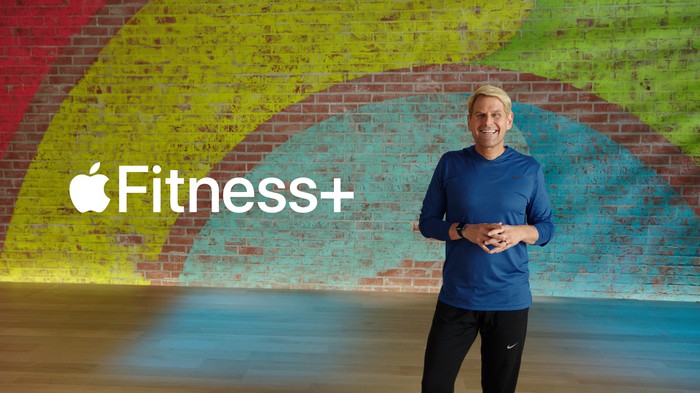In 1984, it came for the personal computer. In 2007, it changed the way consumers used cellphones. In 2015, it strapped technology to our wrists. Now, in 2020, Apple, Inc. (NASDAQ:AAPL) is taking aim at personal fitness. Given its track record of disruption and innovation, this trillion-dollar company will likely remain the apple of many investors’ eyes.
Apple is banking on Fitness+ to work out
In a characteristically glitzy online presentation from its spaceship headquarters in Cupertino, California, on Sept. 15, Apple announced new Apple Watch models, updated iPads, bundled digital services, and something that it hopes forces new rivals like Peloton Interactive (NASDAQ:PTON) to pedal faster — Apple Fitness+. The new service is slated to debut this fall.

Image Source: Apple
Apple Fitness+ is designed to “intelligently incorporate metrics from Apple Watch for users to visualize right on their iPhone, iPad, or Apple TV, offering a first-of-its-kind personalized workout experience,” the company said in a press release. Watch sensors provide real-time feedback on heart rate, calories burned, duration of the workout, and on the new Series 6 Watch, the user’s blood oxygen level. The data is synced to whichever screen you’re watching Apple’s instructor-led workouts on, superimposed in the corner.
Apple’s primary rival in this space is Peloton, equally known for its high-tech exercise bikes and catalog of live and taped instructor-led fitness classes — a newfound competitor Apple seems motivated to undercut. How will Apple do that? The answer is in the hardware … or lack thereof.
I want to ride my bicycle
Peloton created an ecosystem centered around its bikes and treadmills — an initial investment of $1,895 and $2,495, respectively. Now add the “Connected Fitness” membership, and you’re committed to an additional $39 per month. Peloton also offers a “Digital Membership” that doesn’t require Peloton hardware for $12.99 per month. The majority of Peloton customers go all-in with both the bike and/or treadmill plus the higher-level membership, however.

Image Source: Peloton Interactive, Inc.
In its Q4 2020 shareholder letter, Peloton reported 1.09 million Connected Fitness members versus 316,000 Digital subscriptions, for a total of 3.1 million subscriptions. Further, it reported the number of Connected Fitness workouts on the bikes and treadmills combined grew a whopping 333% in Q4 to over 76.8 million. That’s an average of 24.7 monthly workouts per Connected Fitness subscription, more than doubling last year’s numbers.
Peloton said its total revenue grew 172% to $607.1 million in Q4 2020, and in fiscal 2020 total revenue doubled to $1.8 billion. Even to a trillion-dollar valuation company like Apple, that’s not chump change, and precisely why it wants in the market.
Watch this!
Apple CEO Tim Cook is known as a fitness enthusiast, and in his presentation introducing Apple Fitness+ he was especially enthusiastic. The man who told Fortune in 2017 that he woke up at 3:45 a.m. to work out relies on his Apple Watch to guide his exercise regimen and has made it a mission to drive Apple into the fitness space. The Apple Watch was a huge part of that, with sensors that count users’ steps, measure their heart rates, and gamify performance against goals. Apple Fitness+ orbits around the Watch, and it’s the only piece of hardware Apple says users need to succeed.

Image Source: Apple, Inc.
Like everything else in the Apple ecosystem, Apple Fitness+ data derived by the Watch can sync to an iPhone, iPad, Mac, or Apple TV. (Peloton’s Digital subscription content can also be shown on an Apple TV, as well as other streaming boxes like Roku.) The interactive fitness classes appear on the larger devices, and each user’s Watch data gets displayed on their screens, much like the screens on Peloton’s bikes and treadmills. But as mentioned earlier, you don’t need a super-expensive Peloton bike or treadmill to take part in Apple’s new service.
Apple Fitness+ costs $9.99 a month or $79.99 a year, and with the purchase of a new Apple Watch, you get three months free. Also coming this fall is a new bundle of Apple’s digital services, called Apple One. Its highest level, Premier, includes Fitness+, AppleTV+, Apple Arcade, AppleNews+, and two terabytes of iCloud storage for up to five family members or friends to share, for $29.99 a month.
Let’s compare Apples to…Pelotons
For many people wanting to step up their exercise game without spending thousands of dollars, Apple Fitness+ is a very attractive option. For instance, let’s assume you’re starting from scratch and wish to invest in a top-tier digital exercise program, and you have to make the minimum required hardware purchase.
For Peloton, you have to buy a bike for $1,895. Add the top-level subscription to that for $39 a month, and a year of Peloton would set you back $2,317.
For Apple, first, you need to buy an Apple Watch. The newly announced Series 6 starts at $399. Add an Apple Fitness+ subscription for $79.99 per year and you’re looking at $478.99 for the same year of workouts. Apple also announced a budget-priced Watch, called the SE, starting at $279.

The budget-conscious Apple Watch SE. Photo Source: Apple, Inc.
But success or failure of Fitness+ might hinge not on price, but on people. Most everyone has heard about Apple’s cult of personality — “drinking the Kool-Aid,” as they say. The ranks of Apple fandom are deep and devoted, but detractors deride them as a closed-off community.
One of the biggest selling points about the Peloton community is its sense of, well, community — less Kool-Aid, more proprietary energy drink. Peloton took the group fitness class — the spin studio — to the virtual world and brought the group dynamic with it. Even watching instructors on a video screen, there is a sense of being in the moment and true interactivity. Peloton users can send virtual high fives to fellow exercisers and instructors can shout out encouragement to their students with a big, “Keep up the good work, GhostRider 421!” There’s something motivating about participating in a group effort.
Apple Fitness+ appears to be a more individual experience, and it’s possible that relative isolation and lack of connection to others could hold Apple back. So far, Apple’s only previewed Fitness+, with a full launch slated for the coming weeks. We’ll get a clearer picture of its interpretation of community exercise then.
Services are a big part of Apple’s future
Apple’s growing focus on services has helped to catapult it to a trillion-dollar valuation. From iTunes to the App Store to Apple TV to Apple Music to Apple Fitness+, it realizes that creating a culture of customers making repeat purchases is the best way to sustain its 800 lb. gorilla status.

Apple Director of Fitness and Health Technologies Jay Blahnik introduces Apple Fitness+ Image Source: Apple, Inc.
Sure, it will continue to sell boatloads of iPhones and iPads and Macs and Watches, but those are one-time, or once-every-five-years or so, purchases. Enticing customers to buy in for the long run with specialized services like Fitness+ keeps Apple’s revenue stream a torrent — and investor outlooks healthy and glowing while their portfolios remain fit.

